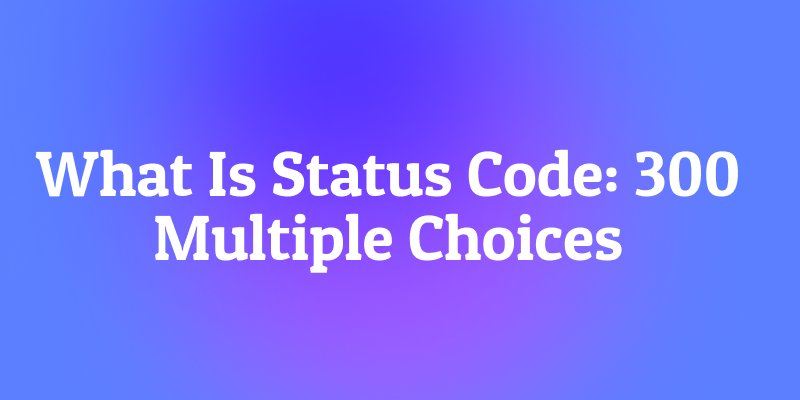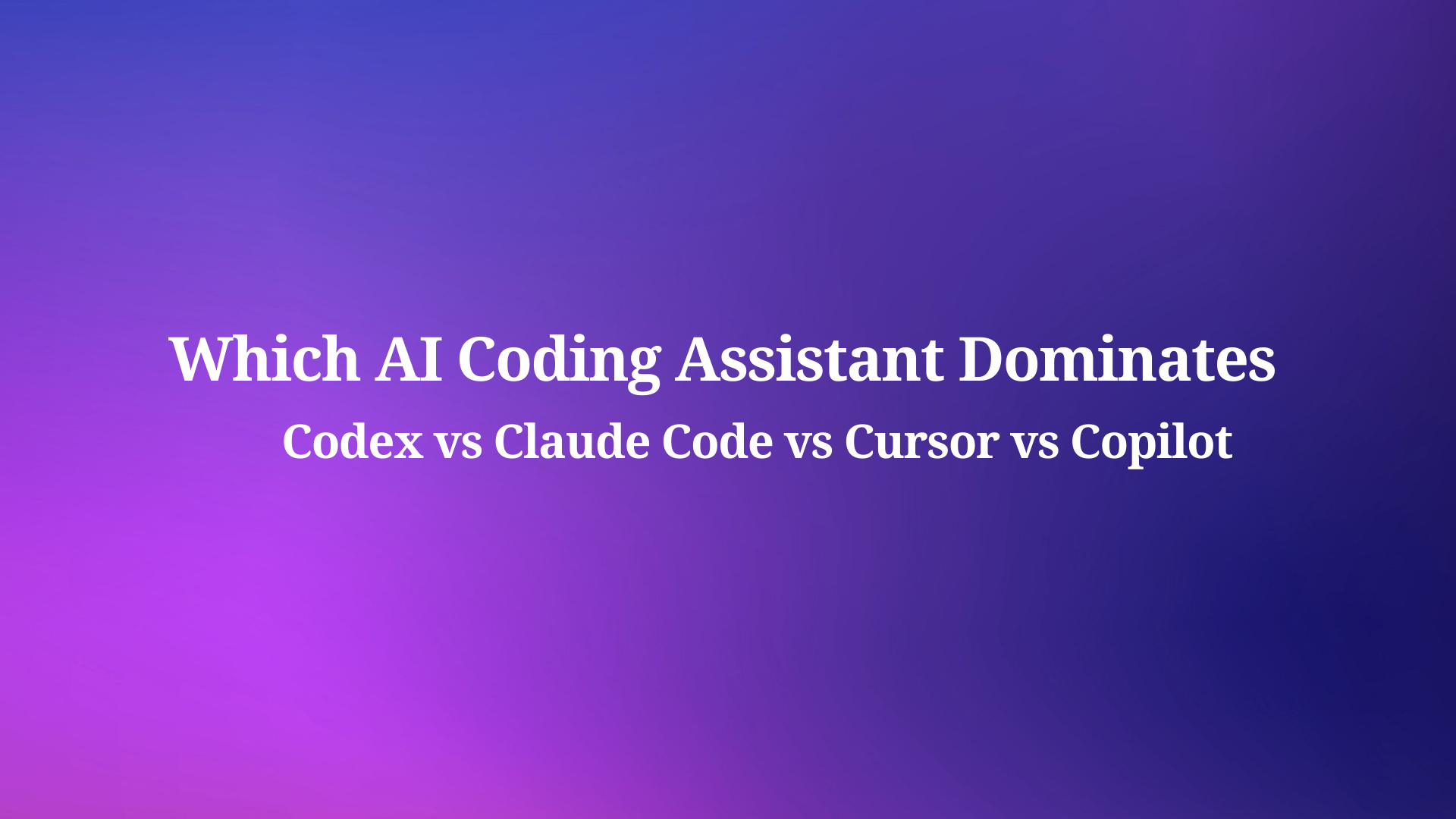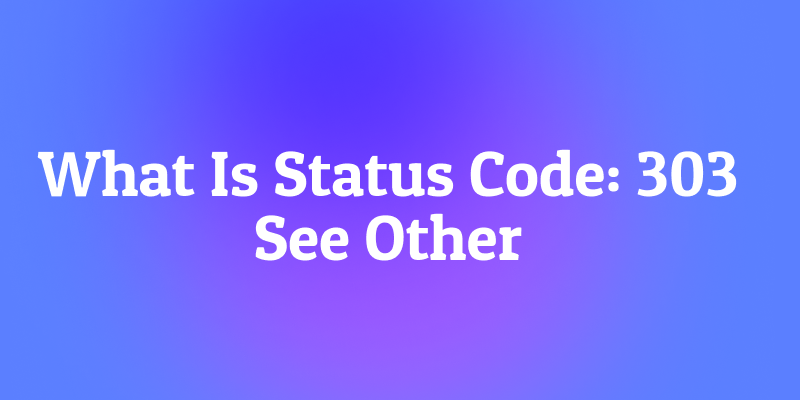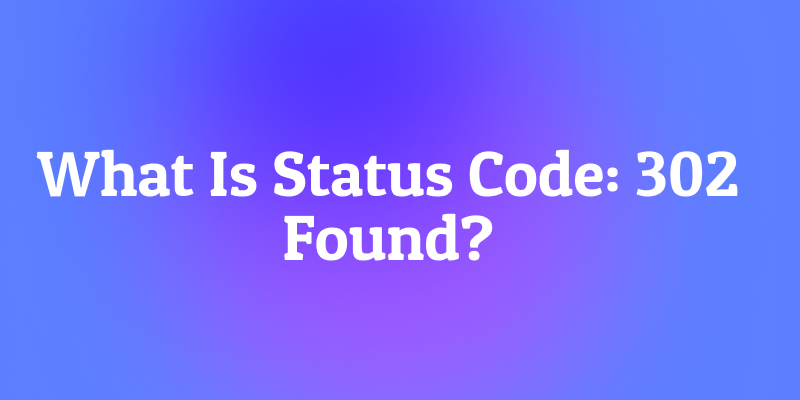You click a link, and instead of being taken to a new page, you see something strange: a page from the server listing several different options for where you could go next. It might be a list of different file formats for a document or different language versions of a website. You, the user, are given a choice.
This unusual behavior is the intended purpose of one of HTTP's most ambiguous and least understood status codes: 300 Multiple Choices.
But have you ever run into 300 Multiple Choices?
At first glance, it sounds vague like the server couldn't make up its mind. And in a way, that's kind of true! The 300 Multiple Choices status code is used when there's more than one possible resource available for a client's request. Instead of just picking one, the server tells the client:
"Hey, there are multiple valid responses. You need to choose which one you want."
Unlike its decisive redirection cousins 301 Moved Permanently and 302 Found, which tells the browser exactly where to go, the 300 code is more of a suggestion. It's the server's way of saying, "I have several different representations of what you asked for. I'm not sure which one you want, so I'll let you, or your browser, choose."
It's the digital equivalent of asking for directions and being handed a map with several potential routes highlighted instead of being pointed down a single path.
If you're a developer or a curious web user, understanding this code is a fascinating dive into a less-traveled path of how the web could have worked.
In this comprehensive blog post, we'll explain what the 300 Multiple Choices status code means, why and when it's used, how it affects client-server communication, and how you, as a developer, can handle it effectively. If you want to mock and test unusual status codes like 300 Multiple Choices, you don't need to spin up a custom server from scratch. You can use Apidog, an all-in-one platform for API design, mocking, testing, debugging and documentation. With Apidog, you can simulate a 300 Multiple Choices response and see how your app reacts, giving you better control over your API behavior. And the best part? You can download it for free.
Now, let's explore everything you need to know about HTTP status code 300 Multiple Choices.
What Is HTTP Status Code 300 Multiple Choices?
The 300 Multiple Choices status code is part of the 3xx Redirection class of HTTP response codes. When a server returns a 300 response, it indicates that the request has more than one possible response. In other words, the requested resource corresponds to multiple available options. The server sends a list of these options to the client, allowing it to choose which resource it wants to access.
Instead of sending back a single version, the server provides a list of options so the client can decide which one to fetch.
For example:
- A resource could be available in different formats (e.g.,
JSON,XML, orHTML). - Or it might exist in different languages (like English, Spanish, or Chinese).
- Or maybe the content is available in different resolutions (think images or videos).
In short, 300 says:
"I found what you want, but you have multiple valid choices. Which one would you like?"
Think of it like ordering at a restaurant: when the waiter explains several equally valid dishes, you get to pick which one you'd like. Similarly, the 300 response presents options to the client.
The Origins of the 300 Status Code
The 300 Multiple Choices response was introduced in the HTTP/1.1 specification (RFC 7231). The reasoning was simple:
- As the web grew, resources often needed multiple variants (language, format, device-specific).
- Instead of servers guessing which one a client wanted, they could explicitly say: Here’s the menu. Pick something.
It was designed to provide flexibility and client control.
Why Does 300 Multiple Choices Exist?
You might wonder, why not just redirect to one specific resource and use a 301 or 302 redirect? The reason why 300 Multiple Choices exists is to provide transparency and choice.
Some scenarios call for giving clients more than one option for a resource, rather than assuming what they want. It’s a way for servers to say: "Hey, here are several viable matches for that request. You decide which one fits best."
This approach can improve user experience, support multi-lingual or multi-format content, and make APIs more flexible.
How It Was Supposed to Work: A Theoretical Example
When a server returns a 300 status code, it usually includes a response body or headers that indicate the different available options. The client then uses this information to decide which resource to request next.
Let's imagine a scenario for a university website.
1. The Request: A user from somewhere in the world requests the homepage.
GET / HTTP/1.1Host: www.university.example
2. The Server's Dilemma: The server has the homepage available in English, Spanish, and French. It doesn't know which language the user prefers. Instead of guessing (e.g., by using the Accept-Language header), it decides to let the user choose.
3. The 300 Response:
HTTP/1.1 300 Multiple ChoicesContent-Type: text/html; charset=utf-8
<html>
<head><title>Choose a Language</title></head>
<body>
<h1>Please select your preferred language:</h1>
<ul>
<li><a href="/en">English</a></li>
<li><a href="/es">Español</a></li>
<li><a href="/fr">Français</a></li>
</ul>
</body>
</html>
The server might also include more advanced machine-readable hints in the headers, like a Link header, though this is rarely implemented.
4. The User's Action: The user sees this page in their browser and clicks on "English."
5. The Redirection: The browser then makes a new request to /en, and the server responds with the English homepage and a 200 OK status.
This can happen automatically in browsers or programmatically in APIs.
The Fatal Flaw: Why 300 Multiple Choices is Rarely Used
This seems logical, so why is this code almost never encountered on the modern web? The problems are numerous and fundamental.
1. It Breaks Automation: The web runs on automation browsers, scripts, APIs, search engine crawlers. These agents expect clear instructions. A 300 response forces a human to make a choice, halting any automated process in its tracks. A crawler wouldn't know which link to follow.
2. Poor User Experience (UX): It's a clunky, interruptive experience for the user. Modern best practice is to either:
- Auto-redirect based on the user's language settings (
Accept-Languageheader). - Serve a single page with built-in language switchers.
- Use subdomains (
en.university.example) or different domains (university.example.fr), which are treated as distinct resources from the start.
3. It's Not Efficient: It requires an extra round trip (request -> 300 -> user choice -> new request) instead of a simple, automatic redirect.
4. Ambiguity: The HTTP spec doesn't strictly define how the choices should be presented. Should it be an HTML page? A specific XML format? This lack of a standard makes it unreliable for machines to parse.
Common Scenarios for 300 Multiple Choices
Let's explore some use cases where 300 Multiple Choices can be useful:
- File format negotiation: A server can offer a document in PDF, HTML, or plain text, letting the client pick.
- Language selection: When content is available in multiple languages, 300 informs clients to choose their preferred version.
- Multiple representations: For images or media with different resolutions or encodings.
- APIs with multiple resource versions: A resource might exist with different representations or versions.
What Does a 300 Response Look Like?
The exact format of a 300 response can vary, depending on the server and use case, but typically it contains a list or links.
Here's a simple example of a response with links in the message body:
textHTTP/1.1 300 Multiple Choices Content-Type: text/html
<html>
<body>
<h1>Multiple Choices</h1> <ul>
<li><a href="/resource1.html">Resource 1</a></li>
<li><a href="/resource2.html">Resource 2</a></li>
<li><a href="/resource3.html">Resource 3</a></li> </ul>
</body>
</html>This lets the client or user click or select the resource they want.
Handling 300 Multiple Choices on the Client Side
When your client encounters a 300 response, here’s what it should do:
- Parse the list of options returned by the server.
- Present clear choices to the user (if applicable).
- Allow automated logic to select the most appropriate link based on criteria such as language, format, or version.
- Follow up with a new request to the chosen resource.
Many browsers may prompt users to select manually, but APIs typically need to automate this logic.
300 Multiple Choices vs Other 3xx Status Codes
To better understand 300, let’s compare it to other common 3xx codes:
| Status Code | Description | When to Use |
|---|---|---|
| 300 Multiple Choices | Multiple options for requested resource | When clients should pick from multiple representations |
| 301 Moved Permanently | Resource has been moved permanently | Use if a resource moved to a single new location |
| 302 Found | Temporary redirect | Temporarily direct client to a different resource |
| 303 See Other | Redirect using GET to another resource | After POST, redirect client to a retrieval URL |
| 304 Not Modified | Resource cached, unchanged | Use for caching optimizations |
Unlike 301 or 302 which direct clients automatically, 300 requires client input.
300 vs Other Redirection Codes
| Code | Meaning | Typical Use Case |
|---|---|---|
| 300 | Multiple Choices | Multiple languages, formats, or qualities |
| 301 | Moved Permanently | Permanent new URL |
| 302 | Found | Temporary redirection |
| 303 | See Other | Redirect after POST to another resource |
| 304 | Not Modified | Cached version still valid |
Challenges When Using 300 Multiple Choices
While 300 Multiple Choices can be useful, it does present some challenges:
- Complex client logic: Clients or user agents need to parse options and implement decision logic.
- UX considerations: Presenting multiple options to users may confuse them if not handled well.
- Limited support: Many modern web services prefer automatic redirects or content negotiation headers instead of 300.
- Not widely used: 300 is one of the less commonly observed HTTP status codes.
Why Developers Should Still Know About 300 Multiple Choices
Even though 300 Multiple Choices isn’t common, understanding it is important for a few reasons:
- Better HTTP literacy: Knowing the full spectrum of HTTP codes makes you a stronger developer.
- Improved content negotiation: In APIs or websites serving multiple versions of data, 300 gives a flexible mechanism.
- Debugging edge cases: Sometimes, you’ll encounter a 300 response from legacy systems or specialized servers.
- Server-side control: It’s a tool for server architects to offer choice without guessing.
Implementing 300 Multiple Choices: Best Practices
If you decide to use 300 Multiple Choices for your server or API, here are some tips:
- Clearly format and structure the options list in the response.
- Ensure URLs to options are valid and accessible.
- For API clients, provide clear documentation on how to handle 300 responses.
- Consider fallback automatic redirects (e.g., 301 or 302) for clients that can’t handle 300.
- Use content negotiation headers as an alternative where practical.
Real-World Examples of 300 Multiple Choices
Example 1: Language Variants
A multilingual website offers English, Spanish, and French pages for the same resource path, returning 300 so the user can select.
GET /docs HTTP/1.1Response:
HTTP/1.1 300 Multiple Choices
Content-Type: application/json
{
"available_variants": [
{ "language": "en", "url": "/docs/en" },
{ "language": "es", "url": "/docs/es" },
{ "language": "zh", "url": "/docs/zh" }
]
}
Example 2: Content Format
A file-sharing service may present download links for original, compressed, or alternate file types.
GET /data HTTP/1.1
Response:
HTTP/1.1 300 Multiple Choices
Content-Type: application/json
{
"available_formats": [
{ "type": "application/json", "url": "/data.json" },
{ "type": "application/xml", "url": "/data.xml" },
{ "type": "text/html", "url": "/data.html" }
]
}
Example 3: Media Quality
An API endpoint serving images could return 300 with options for different resolutions or formats.
GET /video HTTP/1.1Response:
HTTP/1.1 300 Multiple Choices
Content-Type: application/json
{
"resolutions": [
{ "quality": "480p", "url": "/video-480.mp4" },
{ "quality": "720p", "url": "/video-720.mp4" },
{ "quality": "1080p", "url": "/video-1080.mp4" }
]
}Benefits of Using 300 Multiple Choices
Using 300 Multiple Choices may sound rare, but it has some real benefits:
- Clarity: Clients get to pick exactly what they want.
- Flexibility: Supports multi-language, multi-format, or multi-quality content.
- Standards compliance: Aligns with HTTP/1.1 specifications.
- Improved UX: Instead of auto-selecting, you can let users decide.
Common Pitfalls and Misunderstandings
- Not widely supported → Most browsers don’t automatically display 300 options.
- Confusion with redirects → Developers often mistake it for
301or302. - Overuse → Returning 300 for simple resources may complicate APIs unnecessarily.
- Caching issues → Clients may cache only one option instead of multiple.
Testing 300 Responses with Apidog
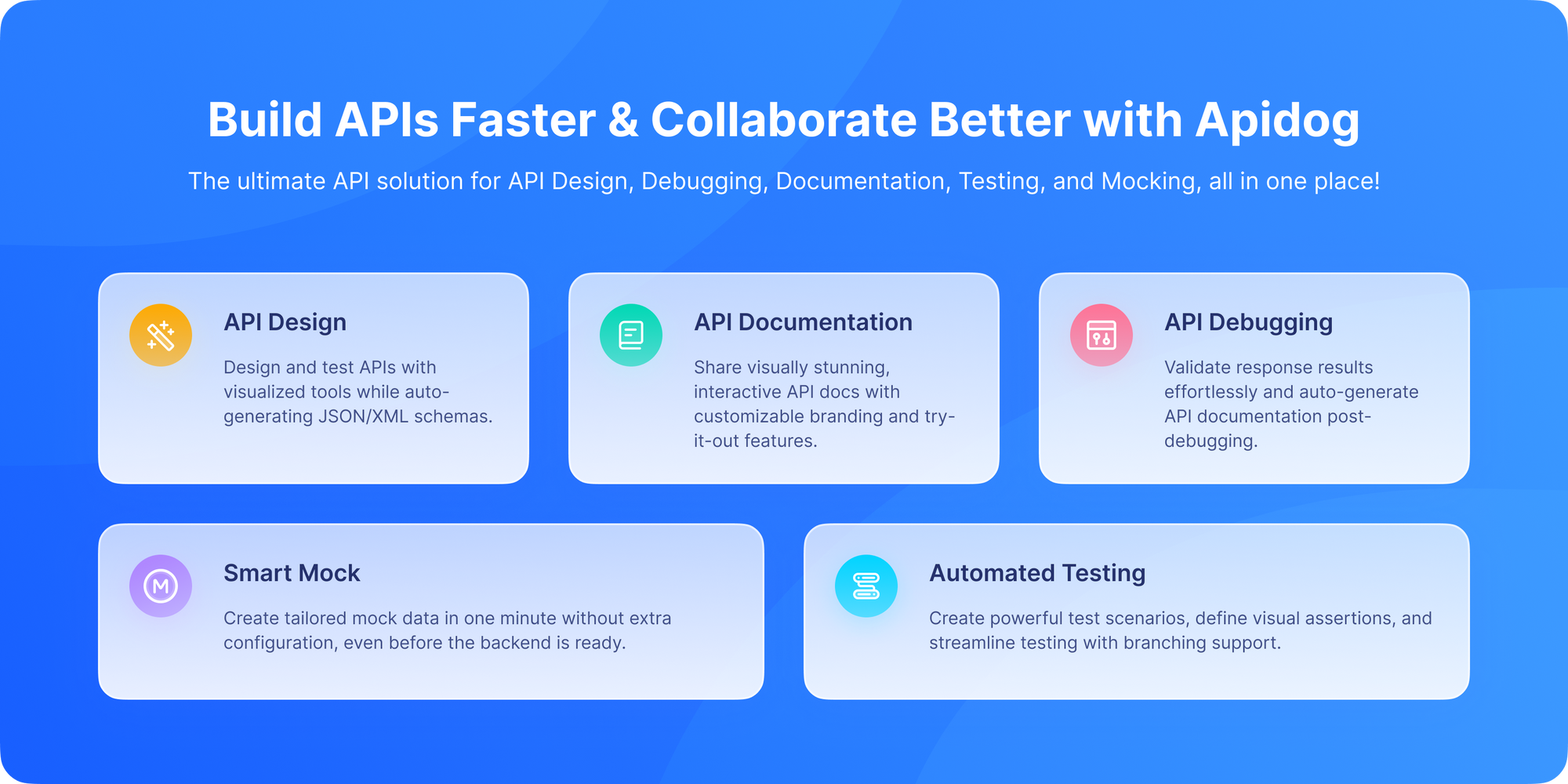
While you'll likely never build an API that returns 300, understanding how to test all possible status codes is a mark of a thorough developer. Apidog is the perfect tool for exploring these HTTP nuances.
With Apidog, you can:
- Mock a 300 Response: Create a mock endpoint in Apidog that returns a
300status with a custom HTML body listing choices. This is great for testing how your application would handle this unusual scenario. - Test Client Resilience: Use your mock endpoint to ensure your client application (e.g., a mobile app or script) doesn't crash when it receives an unexpected
300and has a fallback strategy. - Compare with Modern Practices: Use Apidog to test proper content negotiation. Craft requests with different
AcceptandAccept-Languageheaders and verify that your server correctly responds with302redirects to the appropriate resource. - Document Behavior: If you ever did need to use a
300, you could use Apidog to document the expected response format and choices for other developers.
This way, you don’t need to manually configure a backend just to simulate edge cases. Download Apidog for free and take control of your API testing process even for the trickier HTTP status codes like 300.
Best Practices for Developers
- Use only when necessary: Don’t overcomplicate with 300 if a redirect will do.
- Provide clear metadata: Help clients choose by giving descriptive info.
- Fallbacks matter: If a client doesn’t understand
300, ensure at least one option is accessible. - Document behavior: In your API docs (which you can manage with Apidog!), explain how clients should handle
300.
Advanced Considerations for API Designers
- Negotiate intelligently: Some servers implement content negotiation (choosing the best option automatically) instead of returning 300.
- Provide hyperlinks: Make it easy for clients to follow up on the right choice.
- Combine with headers: Use
Accept-Language,Accept, andUser-Agentheaders to refine options. - Testing & docs: Tools like Apidog help document these edge cases clearly for your team.
The Modern, Better Alternatives
Today, the scenarios where a 300 might have been used are handled in much better ways:
1. For Content Negotiation (Language, Format):
This is the killer feature that made 300 obsolete. The client can state its preferences upfront using headers, and the server can automatically redirect to the best option.
Accept-Language: en, fr;q=0.9-> The browser says "I prefer English, but can accept French."Accept: application/json, text/html;q=0.8-> The API client says "I want JSON if possible, otherwise HTML."
The server can then automatically send a 302 Found or 303 See Other redirect to the most appropriate resource (/en/index.html or /data.json), completely bypassing the need for a manual choice.
2. For Multiple Representations:
If a resource has multiple formats (e.g., PDF, DOCX, TXT), the modern approach is to offer links to all of them on a single 200 OK landing page, not use a 300 response.
Conclusion: Embracing HTTP 300 Multiple Choices in Your Development
HTTP 300 Multiple Choices is a fascinating part of the HTTP ecosystem often hidden from everyday use. Its purpose to offer multiple valid options for a resource gives both servers and clients flexibility, especially when dealing with multi-format, multi-version content.
For developers today, the lesson of 300 is to appreciate the elegance of the modern web's solutions. Using headers for content negotiation and decisive 3xx redirects provides a faster, more reliable, and more automated experience for both users and machines.
In the end, the web evolved in a different direction one of automation, explicit content negotiation, and seamless user experience. The 300 code remains in the specification, a ghost of a potential future that never materialized.
The 300 Multiple Choices status code is one of those HTTP codes that doesn’t come up every day but when it does, it’s powerful.
It tells clients:
"There are multiple valid resources here. You decide which one is best."
This is especially useful in multi-language apps, APIs offering multiple formats, or media with different quality levels.
While its adoption is limited, it represents the flexibility built into HTTP, understanding 300 improves your grasp on web communication and prepares you for edge cases or specialized API requirements.
And remember, to effectively test and document APIs that may return 300 Multiple Choices or any other status code, downloading Apidog for free is an excellent first step. Apidog simplifies interaction with complex HTTP code responses and boosts your productivity.
